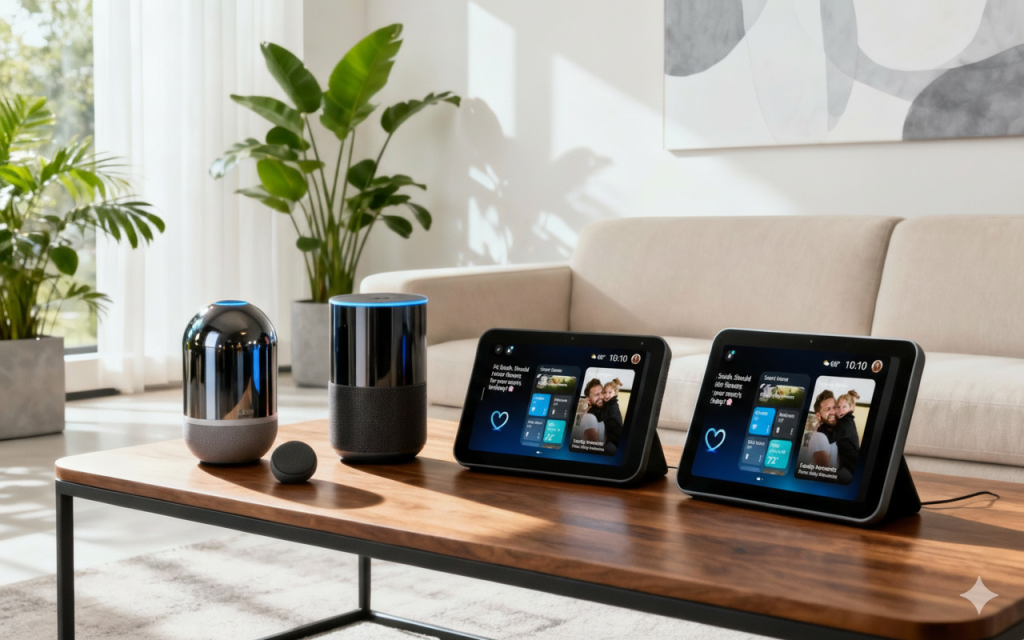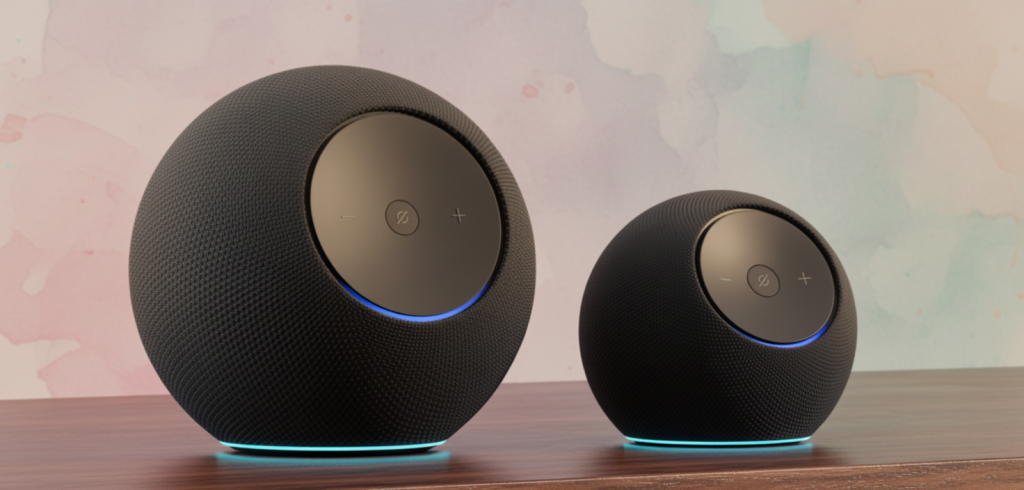
Table of Contents
Alexa+ Echo Devices: Setting the Stage
The Alexa+ Echo devices debuted at Amazon’s September 2025 hardware showcase, where executives pitched them as “the most advanced Echo hardware ever built.” This isn’t just marketing boilerplate. These devices are the first designed from the ground up for Alexa+, a generative AI assistant that reimagines Alexa as less of a chatty voice interface and more of a household manager.
The implications are wider than Amazon would like to admit. A decade ago, the Echo speaker created an entirely new product category: the “smart speaker.” But consumer enthusiasm plateaued. Voice assistants were sometimes amusing, usually shallow, and often more frustrating than freeing. Alexa could play a Spotify playlist or tell you the weather, but it could not actually do much. That gap has haunted Amazon’s device strategy for years.
Alexa+ and the new Echo devices are an attempt to finally deliver on the promise. By adding custom silicon and a dense layer of sensing hardware into your home, Amazon hopes to transform Alexa from a glorified Bluetooth speaker into an AI concierge who anticipates, organizes, and troubleshoots daily life. Whether that excites you or unnerves you depends on how much trust you place in ambient artificial intelligence.
The Four New Models Explained
Amazon’s 2025 lineup includes four Alexa+ Echo devices:
- Echo Dot Max — $99.99
This smallest unit is no longer an entry‑level puck. It features a two‑speaker architecture (woofer + tweeter), delivering three times the bass of the Echo Dot (5th gen). Improved wake‑word accuracy means shouting at Alexa from the kitchen sink won’t be necessary. - Echo Studio — $219.99
Designed for audiophiles but marketed for everyone, this ceramic‑shelled sphere integrates Dolby Atmos and spatial audio. Despite its size shrinking 40 percent compared with the original Studio, the sound is fuller and more immersive. - Echo Show 8 — $179.99
Positioned as the “sweet spot,” this smart display is fitted with front‑facing stereo speakers and a redesigned screen that adapts brightness and visuals to your environment. With its built‑in 13MP camera, it doubles as a center for Ring video feeds and family calendars. - Echo Show 11 — $219.99
The largest display in this cycle, engineered for sharper clarity and viewing angles. It aims to be the household hub: a screen for shopping lists, shared schedules, workouts, or cooking how‑tos while Alexa+ hovers as a personalized mediator.
All ship with Alexa+ Early Access, meaning you no longer sign up for the next‑gen assistant — it simply comes embedded CNBC.
Silicon and Sensors Driving the Upgrade
The engineering upgrades are under the hood.
- AZ3 chip in the Echo Dot Max delivers improved conversation detection and filters background noise. Amazon claims a 50% jump in wake‑word recognition accuracy.
- AZ3 Pro chip in the Studio and both Shows supports more complex natural language processing, plus computer vision via onboard transformers.
Then comes Omnisense, the sensor fusion platform pulling data from:
- 13‑MP cameras on Echo Shows
- Ultrasound readings
- Wi‑Fi channel state information (CSI)
- Accelerometers and radar
Applied together, Omnisense lets Alexa+ decode “context.” A door opens at 10 p.m., and Alexa reminds you to lock up. A specific family member enters, and the Echo Show quietly pulls up their calendar or personalized playlist.
On one level, remarkable engineering. On another, it’s hard to imagine a more corporate‑branded form of surveillance — a device that knows your doors, your habits, your preferred lighting, and who just came through the hallway.

Alexa+ as an AI Agent, Not Just a Voice Bot
Where Alexa once answered trivia and streamed music, Alexa+ Echo devices now act like an agent. Amazon is opening an Alexa+ Store where users can activate TaskRabbit, Uber, Fandango, and Lyft integrations alongside Amazon Music and Kids+. In theory, you can tell Alexa to “sort dinner for Thursday,” and she will check conflicting schedules, recommend a restaurant that fits dietary restrictions, make the reservation, and even add travel time to the family’s shared calendar.
For Amazon, this is the holy grail. A voice assistant that executes tasks independently is far stickier than a voice assistant that answers trivia questions. Stickiness drives commerce, data, and habitual reliance. If Alexa+ becomes your digital butler, replacing her would be near impossible.
Privacy Tradeoffs and Democratic Concerns
But here lies the political economy tension. Alexa+ Echo devices are ambient computers armed with cameras, always‑on microphones, and now radio‑frequency sensors that can map movements within your home. Amazon emphasizes its privacy dashboards, encryption, and “local-first” compute, but democratic resilience requires more than good intentions.
An assistant that organizes your family’s schedules is valuable. An assistant that remembers your shopping history and pushes you toward Whole Foods is also a subtle ad broker. The same sensors that help you monitor your front door can easily normalize passive data extraction from private living spaces.
Consumer rights groups will likely call for legally binding defaults:
- Explicit opt‑in for facial or movement recognition
- Mandatory on‑device deletion of sensitive data
- Transparent logs of what data was collected and why
If left unchecked, a device meant to coordinate daily life risks slipping into corporate surveillance — and once normalized, rolling that back will be nearly impossible.
The Competitive Tech Landscape
Amazon is not moving in isolation. Meta has released Ray‑Ban glasses with on‑board AI. Google’s Gemini is stitched into Android. Apple has unveiled “Apple Intelligence” with promises of privacy‑focused device learning.
Amazon’s differentiator is geography: the home. By embedding Alexa+ into Echo devices distributed across 600 million customers worldwide, the company commands real estate no rival can easily capture. If you buy one of these speakers or displays, Alexa+ becomes the air traffic controller of family logistics, entertainment, and even health nudges via Oura Ring data.
It’s also part of a much broader race to monetize ambient AI. Competitors are already pushing assistants from chat windows into commerce. Just this week, OpenAI announced its “instant checkout” feature inside ChatGPT — essentially putting a buy button directly into conversations — another reminder that big tech views assistants as shopping channels as much as helpers (read our full report here).
The stakes are high. If consumers accept Amazon as the silent mediator of daily life, everything from grocery orders to media playback becomes a frictionless loop through Amazon’s ecosystem. If they resist — because of privacy fears or competing devices — Alexa risks irrelevance.
Why Amazon Is Doubling Down on the Home
Panos Panay, now leading Amazon Devices after 19 years at Microsoft, understands physical platforms. By embedding cutting‑edge AI into polished hardware that looks natural in a living room, Amazon is effectively re‑running the 2014 playbook that birthed the smart speaker category. Only this time, the assistant is not a party trick but an organizing system.
This is what makes the Alexa+ Echo devices so consequential: they are designed not just to sound better or look sleeker, but to integrate Alexa permanently into the cadence of households, without requiring users to constantly “call her up.” That’s the vision of ambient AI: she’s just there, waiting, nudging, and suggesting.
Final Analysis: A Future That Feels Familiar
The four Alexa+ Echo devices represent Amazon’s clearest attempt since the original Echo to shift the category. Technically, they deliver: more powerful chips, richer sound, sharper screens. Strategically, they aim to entrench Alexa as a household agent. Democratically, they raise alarms about invisible surveillance creeping into ordinary routines.
For progressive readers, the rub is that innovation shouldn’t come at the expense of autonomy. These devices feel helpful by default, but without firm guardrails, they risk reinforcing corporate control over private life. Lawmakers who fixate on chatbot policies may want to start paying attention to the ambient AI that is right now setting up shop in kitchens, bedrooms, and living rooms.
Convenience is always seductive. That’s the brilliance of Alexa+. Whether this convenience strengthens or undermines democratic choice is still unfinished business — and the answer won’t just be written in code, but in law.